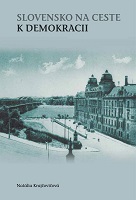Slovensko na ceste k demokracii
Slovakia on the road to democracy
Author(s): Natália Krajčovičová
Contributor(s): Jozef Hupka (Editor)
Subject(s): Politics / Political Sciences, Politics, History, Political history, Recent History (1900 till today), Special Historiographies:, Government/Political systems, Pre-WW I & WW I (1900 -1919), Interwar Period (1920 - 1939), WW II and following years (1940 - 1949), History of Communism
Published by: SAV - Slovenská akadémia vied - Historický ústav SAV
Keywords: Slovakia; Czechoslovak Republic; history; 20th century; Hungary; political system; communism; democracy;
Summary/Abstract: The formation of the Czechoslovak Republic was confirmed officially on October 28 and 30, 1918 by passing two constitutional acts – the Proclamation of the Czechoslovak National Council in Prague and the Declaration of the Slovak Nation in Turčiansky Svätý Martin. The implementation of Czechoslovak independent statehood, however, required another two years of consolidation in the territory of Slovakia, a period which ended by signing the Treaty of Trianon in June 1920. The period between these two milestones – October 1918 and June 1920 – was exceptionally demanding for Slovakia and its leading politicians. The author presents in her work “Slovakia on its Path to Democracy“ the complex problems that emerged immediately after the proclamation of the Czechoslovak Republic and that were closely connected with the process of integration of Slovakia into the new state. The crucial problem was especially the great gap caused by different levels of development of Slovakia and the Czech lands. It was exactly this feature that gave rise to new problems in the process of integration of the two territories. The Office of the Minister Plenipotentiary for the Administration of Slovakia was temporarily in charge of the consolidation of the new political situation. The Minister’s task was made more difficult by the efforts of Hungary to regain the territory of Slovakia or at least a part of it. This “war after the war” complicated the proper functioning of the administration and of the democratisation process in Slovakia, which was lawfully initiated and codified by the Revolutionary National Assembly. Many of its provisions could be implemented in the Czech lands only, as Slovakia had to be put under martial law in March 1919 because of new war events, with a military dictatorship being introduced in June 1919. Supplying the citizens with basic needs became more difficult, which led to an increase of post-war social tensions, disgruntled minorities, and even more complicating consequences on the domestic political scene. The author, besides describing the first steps that were made after the creation of the Czechoslovak Republic and the ideological and programmatic trends of Slovak policy, analyses some key issues that the Ministry Plenipotentiary had to face. These were closely linked to the changes in administration, staffing and funding, and the overall authoritative character of the post-war regime in Slovakia. Along with the national, economic, and social difficulties, they influenced the outcome of the general elections in 1920, which did not favour the Slovak middle-class parties, but made leftist parties victorious. In this context, the author focuses on certain prominent personalities of this era: especially Vavro Šrobár, Milan Hodža, and Juraj Slávik. They were representatives of the new Slovakia not only as government ministers, but also as leading politicians of the Agrarian Party, which played an important ideological, political, and economic role in Czechoslovakia from its beginning to its end. It is obvious that some problems that emerged immediately after the formation of Czechoslovakia (e.g. the struggle for Slovak autonomy and official recognition of Slovak national identity) and were not properly resolved, continued to reproduce themselves. They polarised the Slovak political scene to an unfortunately large degree, reappeared after twenty years in a more radical form, and proved fatal to the Republic as a whole and to Slovakia in 1938.
- Print-ISBN-13: 978-80-89396-01-6
- Page Count: 267
- Publication Year: 2009
- Language: Slovak
- eBook-PDF
- Sample-PDF
- Table of Content
- Introduction

